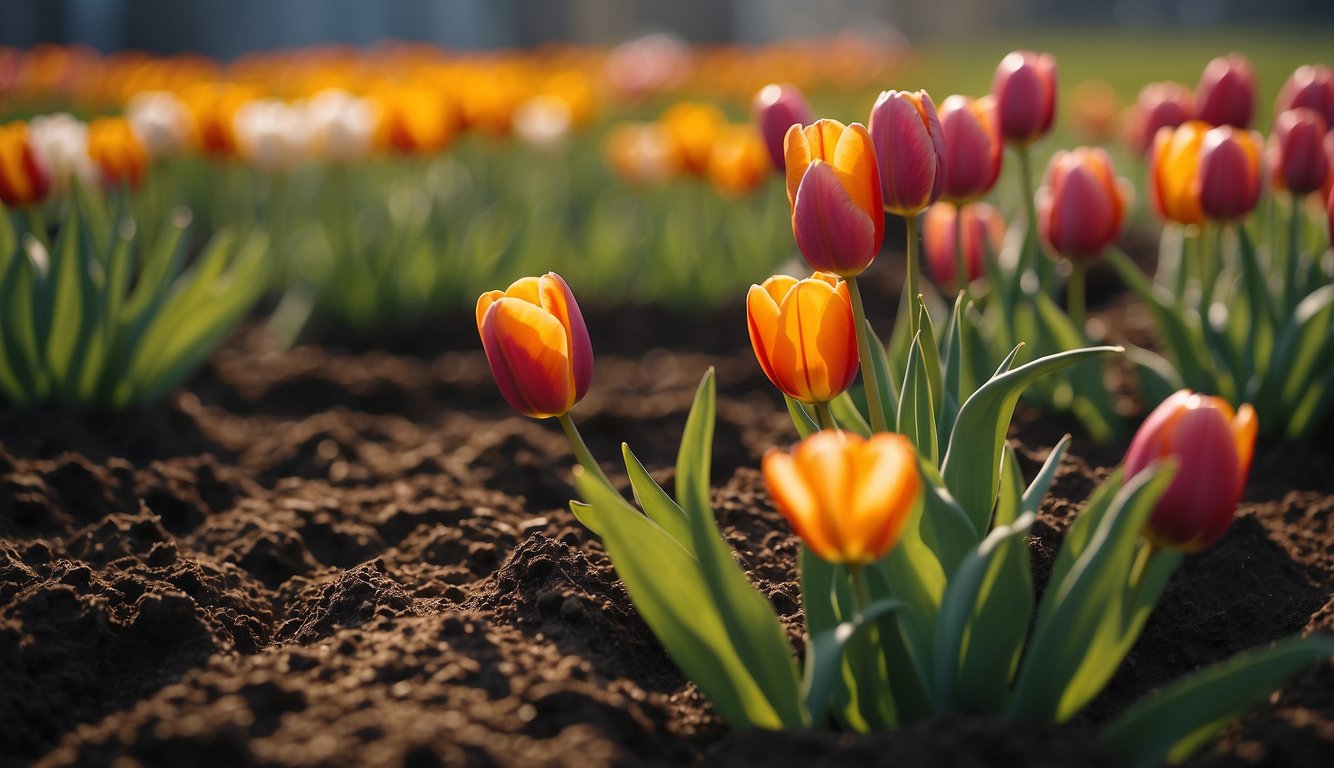TheHerbProf.com is a treasure trove of knowledge for those interested in natural healing and herbal remedies. The website is run by Paul Johnston MD. A naturopathic who has not only received extensive education in the field but also has personal experience in self-healing.
Planting already bloomed tulips can be a rewarding experience for gardeners who want to enjoy the beauty of these flowers beyond their typical blooming season.
Tulips are known for their vibrant colors and come in a variety of shapes and sizes. They are easy to grow and care for, making them a popular choice for both novice and experienced gardeners.
When it comes to planting already bloomed tulips, there are a few things to keep in mind.
First, it’s important to choose a location that receives plenty of sunlight and has well-draining soil.
Tulips prefer soil that is slightly acidic and rich in organic matter. If you’re planting in a garden bed, be sure to work in compost or other organic matter to improve the soil quality.
Another important factor to consider when planting already bloomed tulips is proper care after planting.
This includes watering the bulbs regularly and providing them with the nutrients they need to grow and thrive.
With the right care and attention, planting already bloomed tulips can be a rewarding experience that brings beauty and color to your garden for years to come.
Understanding Tulips – Planting Already Bloomed Tulips
Tulip Varieties
Tulips come in a wide variety of colors, shapes, and sizes. There are over 3,000 registered tulip varieties, which can be classified into 15 different groups based on their characteristics.
Some of the popular varieties include double, Darwin hybrid, Kaufmanniana, fringed, single early, triumph, single late, parrot, and viridiflora tulips.
Tulip Biology
Tulips are bulbous plants that belong to the lily family. The bulb stores nutrients and energy for the plant’s growth and flowering.
The leaves of the tulip plant are long, narrow, and green. The bulb is covered with a papery skin called the tunic, which protects the bulb from damage and drying out.
Tulip Growth Cycle
Tulips have a relatively short growing season, which starts in early spring and lasts for about six weeks.
The tulip plant grows from a bulb, which produces foliage and a flower stem. The tulip flower blooms for a short period, after which the plant goes dormant.
The plant produces seeds after flowering, but most gardeners propagate tulips by planting bulbs, bulblets, or offsets.
Native Habitats and Hardiness
Tulips are native to the mountainous regions of Central Asia, where they grow in rocky, well-drained soils.
Different tulip varieties have different hardiness zones, depending on their native area.
For example, species tulips are more cold-tolerant and can grow in hardiness zones 3-8, while Darwin hybrid tulips are less cold-tolerant and can grow in hardiness zones 4-7.
Growing tulips requires a sunny location with well-drained soil. Tulips are generally planted in the fall, before the first frost, and bloom in the spring. After bloom care is essential to ensure the tulips rebloom the following year.
Pre-Planting Considerations – Planting Already Bloomed Tulips
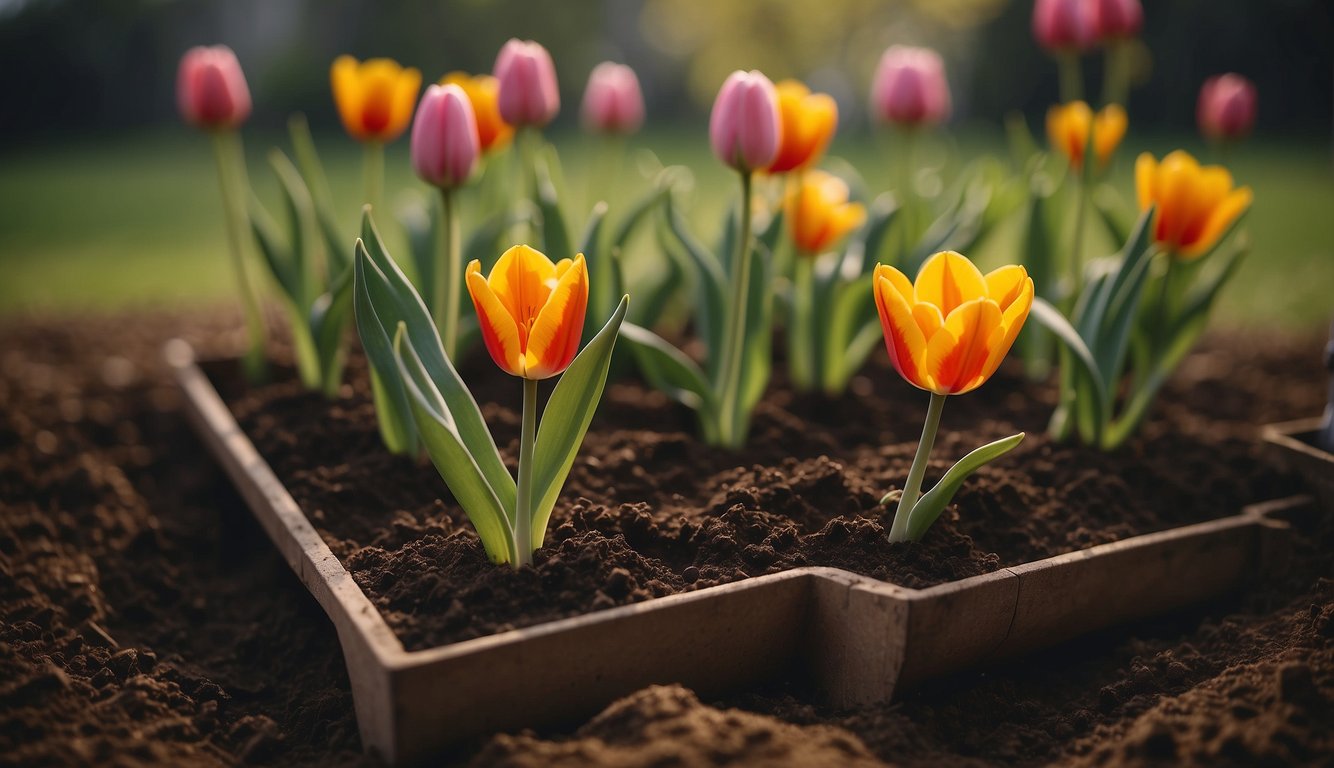
Before planting already bloomed tulips, there are a few key considerations to keep in mind to ensure that your tulips thrive in their new location.
These considerations include soil preparation, choosing the right location, timing and temperature, and selecting quality bulbs.
Soil Preparation
Tulips require well-draining soil that is rich in nutrients.
Before planting, make sure to prepare the soil by removing any weeds or debris and tilling the soil to a depth of at least 8 inches.
If your soil is heavy and clay-like, consider adding organic matter such as compost or peat moss to improve drainage and soil structure.
Choosing the Right Location
Tulips prefer full sun and a sunny location that receives at least 6 hours of direct sunlight per day.
When selecting a location for your tulips, consider the amount of sunlight the area receives and whether it is protected from strong winds.
Timing and Temperature
Tulip bulbs should be planted in the fall, ideally 6-8 weeks before the first hard frost. This allows the bulbs to establish roots before winter and bloom in the spring.
The ideal soil temperature for planting tulip bulbs is between 50-60°F.
Selecting Quality Bulbs
When selecting tulip bulbs, choose bulbs that are firm, plump, and free from any signs of damage or disease.
Larger bulbs will produce larger flowers, so choose bulbs that are at least 1 inch in diameter.
Additionally, consider the color and bloom time of the tulip variety to ensure that it fits your garden design and planting schedule.
By following these pre-planting considerations, you can ensure that your already bloomed tulips will thrive in their new garden location.
Planting Process – Planting Already Bloomed Tulips
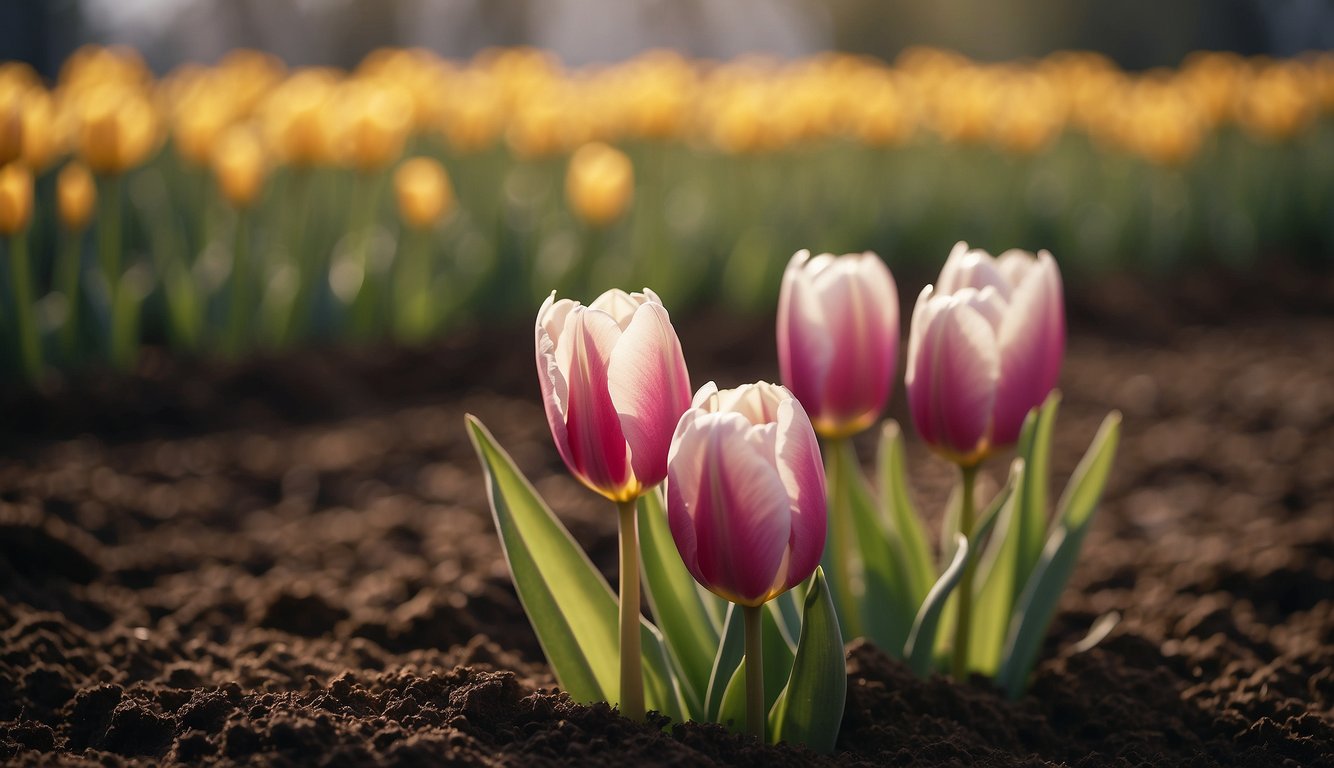
Planting already bloomed tulips can be a bit tricky, but with the right knowledge, it can be done successfully. In this section, I will guide you through the planting process, including planting depth and spacing, watering after planting, and caring for bloomed tulips.
Planting Depth and Spacing
When planting tulips, the depth and spacing are crucial factors that determine the success of your planting.
According to The Old Farmer’s Almanac, tulip bulbs should be planted fairly deep, about 8 inches deep, or about three times the height of the bulb.
Dig a hole deeper than that in order to loosen the soil and allow for drainage. In clay soils, plant 3 to 6 inches deep instead.
Space bulbs 4 to 6 inches apart. Set the bulb in the hole with the pointy end up. Tulips tend to display best if planted in groups of about 10 bulbs.
Watering After Planting
After planting, it is important to water your tulip bulbs well, which will help them establish themselves in the soil.
Once they have grown, water your tulips about once a week or as needed to keep the soil moist.
Too much water can be just as damaging as too little, so be sure not to overwater your tulips.
According to GardenersMag, tulips need well-drained soil, so make sure the water doesn’t pool around the bulbs.
Caring for Bloomed Tulips
After your tulips have bloomed in pots, you can plant them outside. Begin preparing potted tulips for outdoor planting as soon as the petals fade.
Keep plants inside, preferably in a south- or east-facing window, at normal room temperature.
Remove dead flowers, clipping the stem close to the base of the plant.
According to Hunker, disinfect clippers before and after cutting by soaking for 5 minutes in a 50-50 solution of rubbing alcohol and water.
Once you have planted your tulips, be sure to keep the soil moist and well-drained. Tulips need regular watering to thrive.
Post-Bloom Care – Planting Already Bloomed Tulips

After tulips have bloomed, it is important to provide them with proper care to ensure they come back next year. Here are some tips on how to care for your tulips after they have bloomed.
Fertilization and Nutrients
Fertilizing your tulips after they have bloomed is important to ensure they have the nutrients they need to grow strong and healthy.
Apply a balanced fertilizer, such as 10-10-10, to the soil around the tulips. You can also add bone meal to the soil to provide additional nutrients.
Pruning and Deadheading
Deadheading spent blooms is an important step in post-bloom care. This involves removing the dead flowers from the plant to encourage new growth.
Gardeners should cut off the spent blooms using sharp scissors or pruning shears, being careful not to damage the foliage or stem.
Deadheading also helps to prevent the tulip from putting energy into seed production, which can weaken the plant.
Dividing and Propagating
Tulips can be divided and propagated after they have bloomed. This is a good way to increase the number of tulips in your garden.
Wait until the foliage has died back and then carefully dig up the bulbs. Separate the bulbs and replant them in a new location. Be sure to plant them at the correct depth and spacing.
Disease and Pest Management
Tulips can be susceptible to disease and pests.
Watch for signs of damage or disease, such as yellowing leaves or spots on the foliage.
If you suspect a problem, remove the affected plant and dispose of it. You can also use insecticides or fungicides to treat the problem.
Be sure to follow the instructions carefully and use the appropriate product for the specific problem.
Seasonal Maintenance – Planting Already Bloomed Tulips
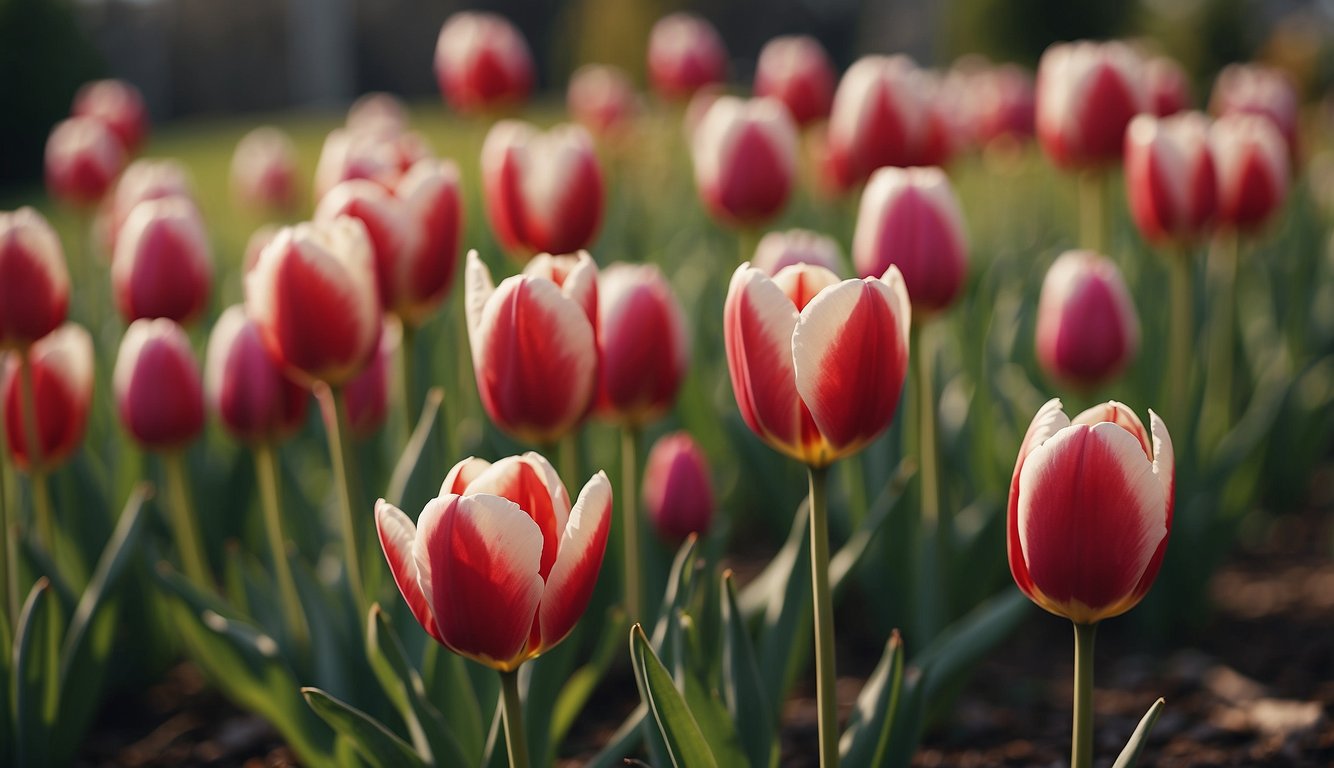
As a gardener, I know that tulips are one of the most beautiful flowers to have in a garden. They are easy to grow and come in a wide range of colors.
However, planting tulips can be a bit tricky, especially if you are planting already bloomed tulips. In this section, I will share with you some tips on seasonal maintenance for already bloomed tulips.
Summer Care
During the summer months, tulips go through a period of dormancy. This means that they do not require much care during this time.
However, it is important to keep the soil moist, but not waterlogged. This can be achieved by watering the plants once a week.
Avoid overwatering, as this can lead to root rot.
Fall Activities
Fall is the best time to plant tulips. If you have already bloomed tulips, you can plant them in the fall for next year’s bloom.
When planting, make sure to plant the bulbs at a depth of at least 6 inches. This will help to protect them from the cold winter months.
You can also add a layer of mulch to help insulate the bulbs.
Winter Considerations
In the winter months, tulips go through a period of dormancy. During this time, it is important to keep the soil moist, but not waterlogged. This can be achieved by watering the plants once a week.
Avoid overwatering, as this can lead to root rot.
It is also important to store the bulbs in a cool, dry place.
You can store them in a paper bag or in a mesh bag. Avoid storing them in plastic, as this can lead to mold growth.
Special Topics – Planting Already Bloomed Tulips
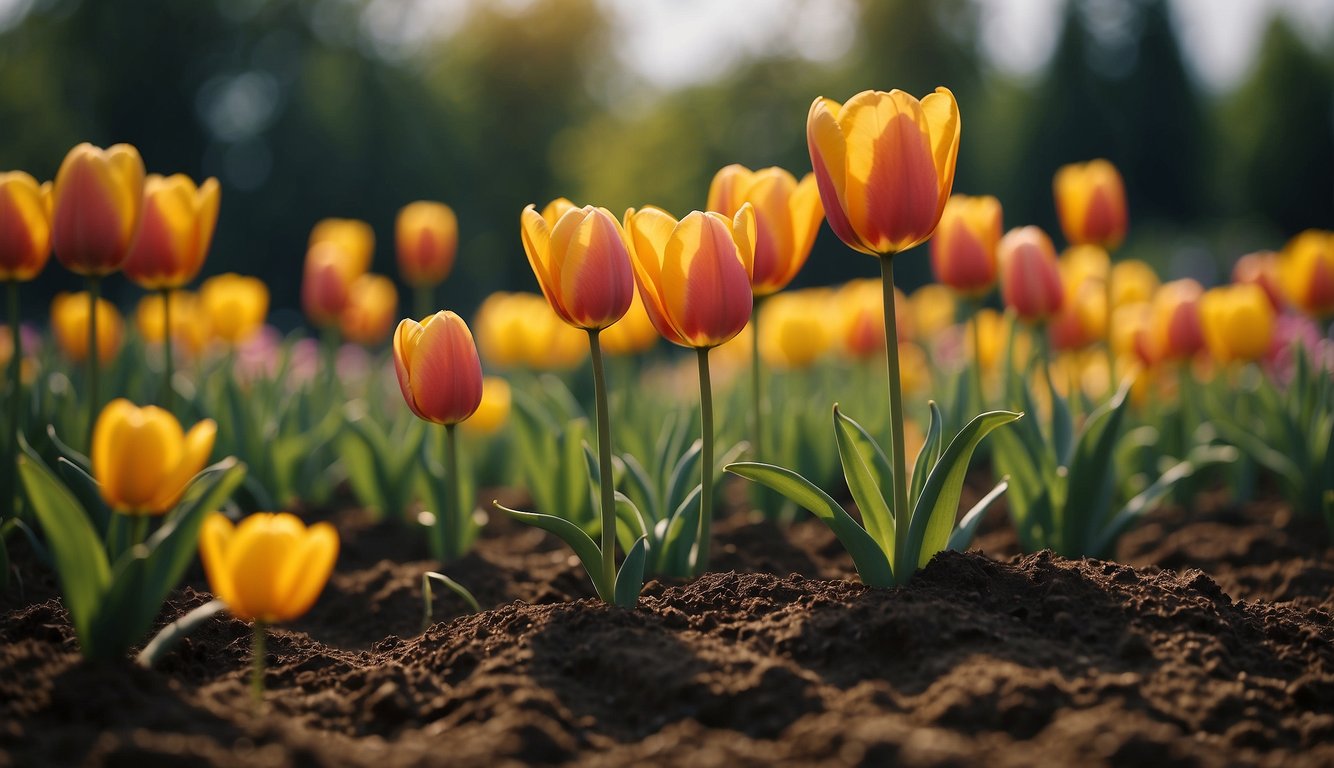
Hybrid and Special Tulip Types
There are many different types of tulips available, from the classic single-flowered species to the more exotic hybrids such as the Darwin hybrids, parrot tulips, and lily-flowered tulips.
These hybrid and special tulip types are known for their unique characteristics, such as their ruffled petals, bold flower colors, and unusual shapes.
When planting already bloomed tulips, it’s important to consider the specific needs of the hybrid or special tulip type you are working with.
Some may require more sun or shade, while others may prefer a specific type of soil. Be sure to research the specific requirements of your tulip type before planting.
Companion Planting
Tulips can be a great addition to any garden, but they also benefit from companion planting.
Planting tulips alongside other perennials or annuals can help to protect the bulbs from pests and diseases, and can also add color and interest to your garden.
When choosing companion plants for your tulips, consider plants that have similar growing requirements and will bloom at the same time.
Daffodils, for example, are a great companion plant for tulips, as they have similar soil and light requirements and will bloom at the same time.
Tulip Propagation Techniques
If you want to propagate your tulips, there are a few different techniques you can use.
One option is to divide the bulbs, which involves separating the bulbs into smaller sections and replanting them. This can help to rejuvenate older bulbs and encourage new growth.
Another option is to propagate your tulips using bulblets or offsets.
These are small bulbs that form at the base of the main bulb, and can be removed and replanted to create new plants.
Be sure to wait until the bulblets or offsets have developed their own roots before separating them from the main bulb.
Troubleshooting Common Issues – Planting Already Bloomed Tulips
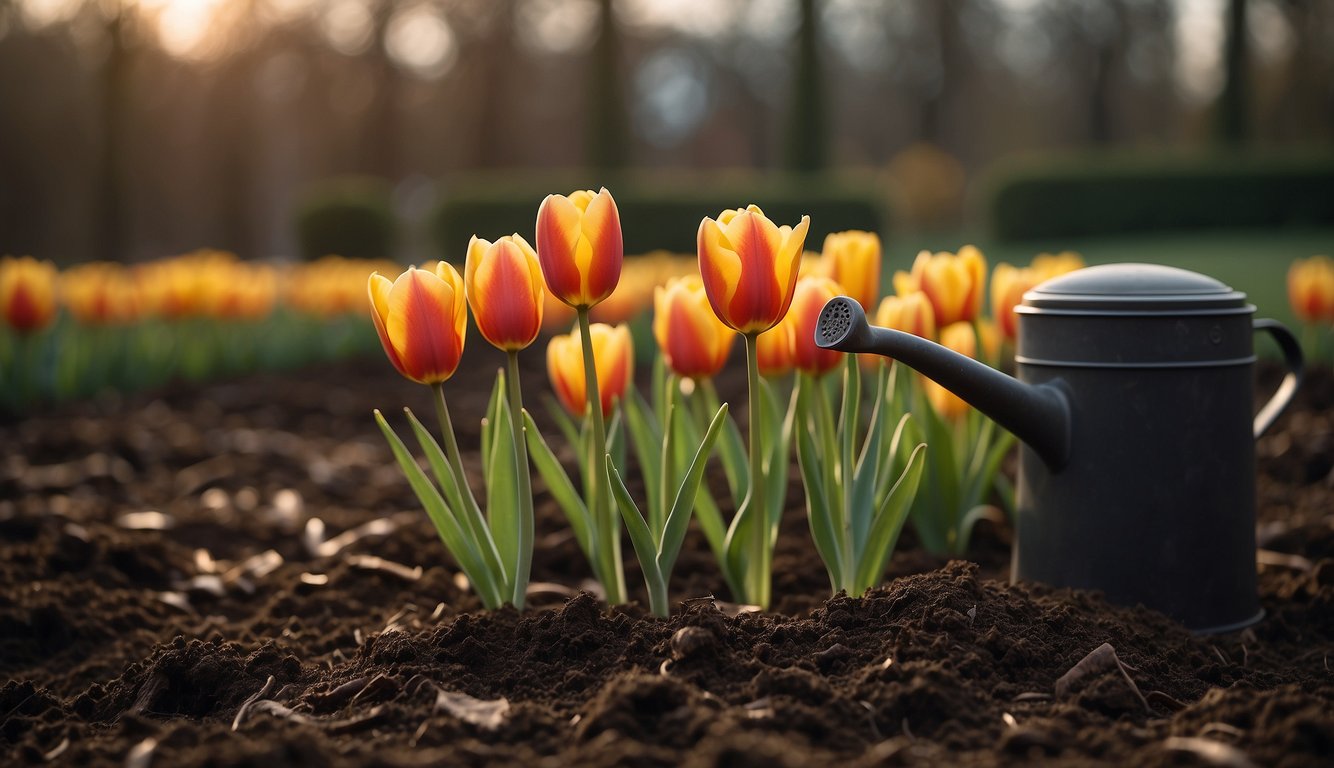
When planting already bloomed tulips, it is important to be aware of common issues that can arise. Here are some troubleshooting tips to help you care for your tulips and keep them healthy.
Pests and Diseases
One common issue that can affect tulips is pests and diseases.
Some pests that can damage tulips include aphids, slugs, and snails. To prevent pests from damaging your tulips, you can use insecticidal soap or neem oil.
These products are safe for use on plants and can help to control pests.
Diseases can also be a problem for tulips.
Some common tulip diseases include tulip fire, which causes brown spots and twisted leaves, and botrytis blight, which causes brown spots and rotting.
To prevent diseases, make sure to plant tulips in well-drained soil and avoid overwatering.
If you notice signs of disease, remove affected leaves and dispose of them in the trash.
Damage
Another common issue that can affect tulips is damage.
Tulips can be damaged by extreme weather conditions, such as frost or heavy rain. To protect your tulips from damage, you can cover them with a frost cloth or move them to a sheltered location.
Tulips can also be damaged by animals, such as squirrels or rabbits.
To prevent animal damage, you can use wire mesh or chicken wire to cover your tulips.
Planting Tulips
When planting already bloomed tulips, it is important to plant them at the right depth.
Tulips should be planted at a depth of 6 to 8 inches. If you plant them too shallow, they may not bloom properly. If you plant them too deep, they may not come up at all.
It is also important to plant tulips in well-drained soil.
Tulips do not like wet feet, so make sure the soil drains well. If you have heavy clay soil, you can amend it with sand or compost to improve drainage.
Tulip Care
To care for your tulips, make sure to water them regularly.
Tulips need about 1 inch of water per week. If you live in a dry climate, you may need to water them more often.
It is also important to fertilize your tulips.
You can use a balanced fertilizer, such as a 10-10-10, in the spring when the leaves are just starting to emerge. Be careful not to over-fertilize, as this can damage the bulbs.
Planting Already Bloomed Tulips: A Herbalist’s Perspective
Let’s talk about tulips. Yes, those vibrant, cup-shaped beauties that herald the arrival of spring. But wait, we’re not just planting tulips, we’re planting already bloomed tulips. Sounds intriguing, right? Let’s dive in!
First off, why would anyone want to plant already bloomed tulips? Well, it’s all about giving and receiving. Tulips, like us, are part of a bigger ecosystem. When we plant them, they give back to us and to the environment in so many ways.
Think about it. Tulips add color and beauty to our gardens. They attract pollinators. And guess what? They can even improve the health of our other plants. Yes, you heard it right! Tulips can help other plants in your garden thrive. How cool is that?
Now, let’s talk about how this ties back to our home page, theherbprof.com. Our website is a treasure trove of information on herbs and their benefits. And guess what? Tulips, in their own way, are contributing to the herbal world.
By planting already bloomed tulips, we’re creating a vibrant ecosystem. This ecosystem supports the growth of various herbs. It’s a win-win situation. The tulips get a place to grow, and in return, they support the growth of our beloved herbs.
So, next time you see a bloomed tulip, don’t just admire its beauty. Plant it! And remember, by doing so, you’re not just planting a flower. You’re planting a mini-ecosystem. You’re contributing to the circle of life in your garden. And most importantly, you’re taking one more step towards becoming a true herb enthusiast.
References – Planting Already Bloomed Tulips
Little Herb Encyclopedia, by Jack Ritchason; N.D., Woodland Publishing Incorporated, 1995
The Ultimate Healing System, Course Manual, Copyright 1985, Don Lepore
Planetary Herbology, Michael Tierra, C.A., N.D., Lotus Press, 1988
Handbook of Medicinal Herbs, by James A. Duke, Pub. CRP Second Edition 2007
The Complete Medicinal Herbal, by Penelope Ody, Published by Dorling Kindersley
Check the Following Articles!
Coffee Grounds in Garden Benefits Of
Best Way to Use Aloe Vera Plant
Different Kinds of Root Vegetables
Kale Types: A Guide to the Different Varieties of Kale
Frequently Asked Questions – Planting Already Bloomed Tulips
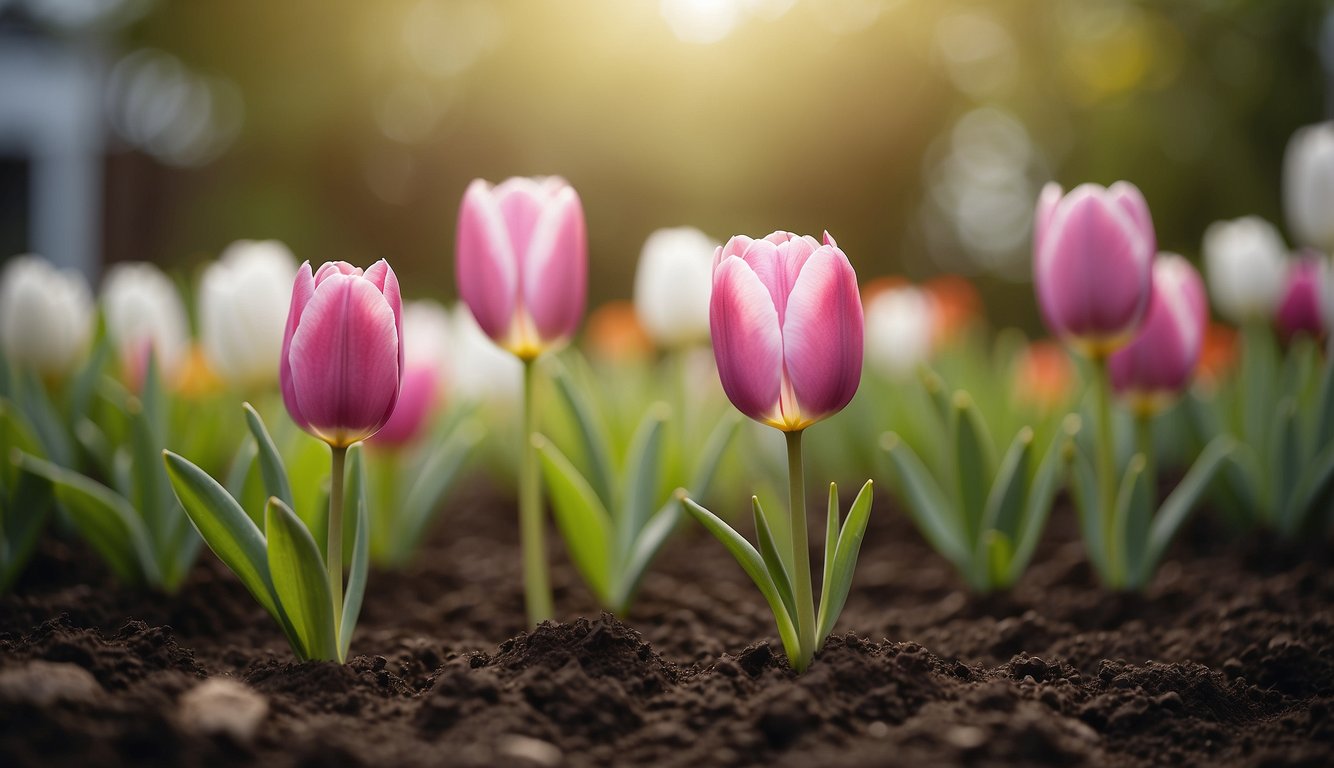
As an experienced gardener, I often get asked about planting already bloomed tulips. Here are some of the most frequently asked questions and their answers:
When is the best time to plant already bloomed tulips?
The best time to plant already bloomed tulips is in the fall, about 6-8 weeks before the ground freezes. This allows the bulbs to establish roots before winter sets in.
Planting tulips in the spring is also possible, but the bulbs may not have enough time to establish roots and may not flower the following year.
What is the best soil type for planting already bloomed tulips?
Tulips prefer well-draining soil that is rich in organic matter. A sandy loam soil is ideal for planting tulips.
If your soil is heavy and clayey, you can amend it with compost or peat moss to improve drainage.
How deep should I plant already bloomed tulips?
Tulip bulbs should be planted about 6-8 inches deep, with the pointed end facing up. Planting too shallow can result in frost damage, while planting too deep can delay flowering.
How often should I fertilize already bloomed tulips?
Tulips do not require frequent fertilization.
You can apply a balanced fertilizer, such as a 10-10-10 formula, in the fall when planting the bulbs. Avoid fertilizing in the spring, as this can promote leaf growth at the expense of flowers.
What are some common pests and diseases that affect already bloomed tulips?
Tulips are generally pest and disease resistant, but they can be affected by aphids, slugs, and fungal diseases such as botrytis and tulip fire.
To prevent these problems, make sure to plant tulips in well-draining soil, avoid overcrowding, and practice good garden hygiene by removing dead leaves and flowers.
What are some popular tulip varieties for planting already bloomed tulips?
There are many different tulip varieties to choose from, including single early tulips, double late tulips, parrot tulips, and more.
When selecting tulip bulbs, consider factors such as color, height, and flowering time.
Can I propagate already bloomed tulips?
Tulips can be propagated by dividing the bulbs after they have finished flowering.
Wait until the foliage has died back, then carefully dig up the bulbs and separate them into smaller sections. Replant the sections immediately, or store them in a cool, dry place until planting time.
Frequently Asked Questions – Planting Already Bloomed Tulips
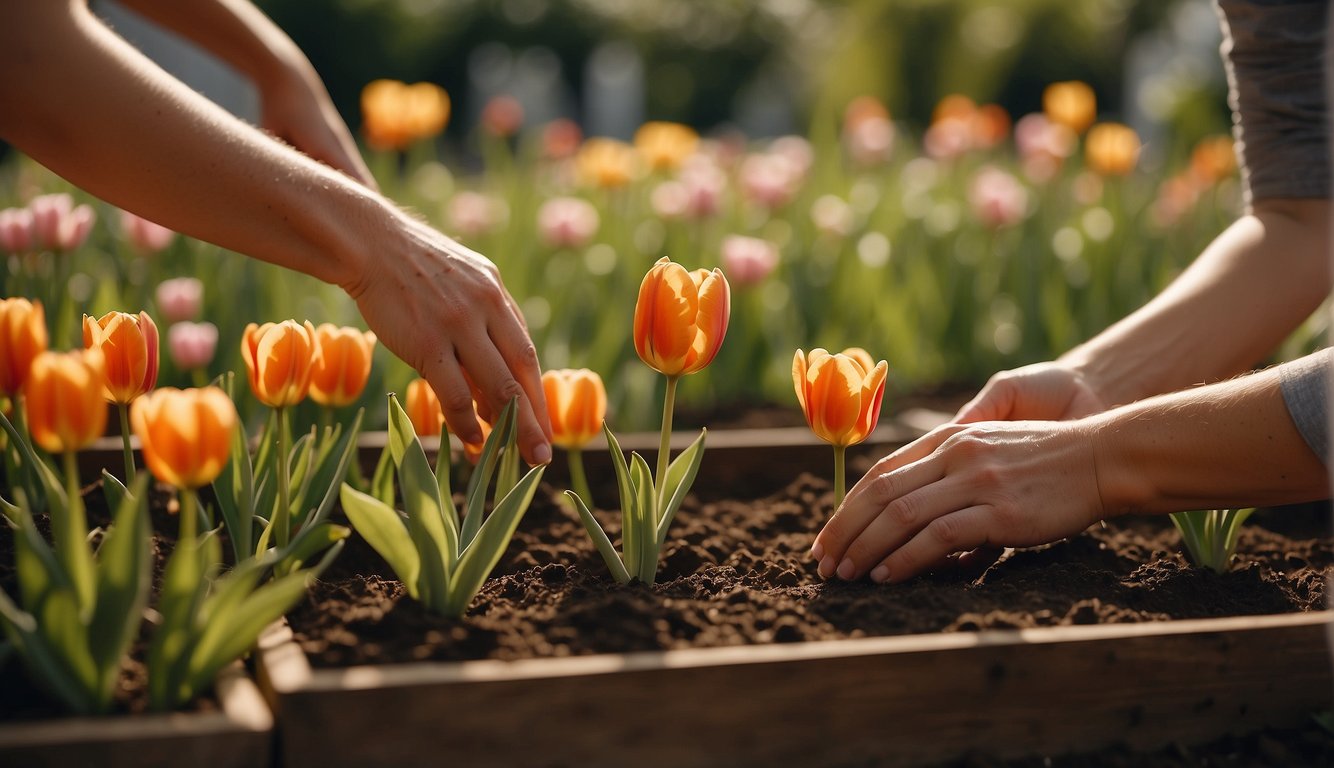
How should tulips be cared for in pots after they have flowered?
Once the tulips have finished blooming, it’s important to deadhead the spent flowers to encourage new growth. According to Grow Happier Plants, you should trim the spent flowers as soon as they start to wilt or lose their petals.
Cut off the faded bloom an inch or so below the head, leaving the stem and leaves intact.
While it may be tempting to cut back the entire plant after the flowers have faded, resist the urge! The leaves play a crucial role in the tulip’s growth cycle, and if you cut them, the bulb won’t get the nutrients it needs to produce new flowers next year.
Is it possible to get tulips to bloom again after they have been grown in water?
It is possible to get tulips to bloom again after they have been grown in water, but it can be difficult. According to Hunker, you should begin preparing potted tulips for outdoor planting as soon as the petals fade.
Keep plants inside, preferably in a south- or east-facing window, at normal room temperature. Remove dead flowers, clipping the stem close to the base of the plant. Disinfect clippers before and after cutting by soaking for 5 minutes in a 50-50 solution of rubbing alcohol and water.
What are the best practices for planting tulips indoors after they’ve already bloomed?
If you want to plant tulips indoors after they’ve already bloomed, there are a few things to keep in mind. According to Yard and Garden Guru, you should work a 2-inch layer of compost into the top 8 inches of a garden bed that gets full sun and good drainage.
Compost enhances soil quality and boosts soil nourishment.
Cut the tulip bulbs’ dead foliage off. Then, from the pot, take out the bulbs. Plant the tulip bulbs in the bed with the pointed side upward.
How can you successfully transplant tulips that have bloomed once into the garden?
Transplanting tulips that have bloomed once into the garden can be done successfully with a few simple steps. According to Plant Native, you should dig a hole in the ground that is twice the size of the tulip bulb.
Add some compost to the bottom of the hole, and then place the bulb in the hole with the pointed end facing up.
Cover the bulb with soil, and water it well.
Make sure to plant the tulip bulbs at the right depth. Tulips should be planted about 6 inches deep.
What is the typical bloom cycle for tulips, and do they flower multiple times?
Tulips typically bloom once a year in the spring, usually in April or May, depending on the climate. They do not flower multiple times in a year, but with proper care, they can bloom for several years in a row.
According to The Practical Planter, tulips are bulbous plants. The bigger the bulb is, the bigger the flowers it usually produces.
Planted in late fall, they emerge in early spring, and as they do, the bulbs split. Once tulips have bloomed, the bulbs in the ground are divisions of the parent bulb.
After Easter, how can one manage and plant gifted tulip bulbs that have bloomed?
If you have received tulip bulbs as a gift after Easter, you can still plant them in your garden.
According to Yard and Garden Guru, you should plant them as soon as possible after receiving them.
Choose a sunny spot in your garden with well-draining soil.
Dig a hole that is twice as deep as the bulb is tall, and add some compost to the bottom of the hole.
Place the bulb in the hole with the pointed end facing up, and cover it with soil.
Water the bulb well, and keep the soil moist until the bulb has established itself.
